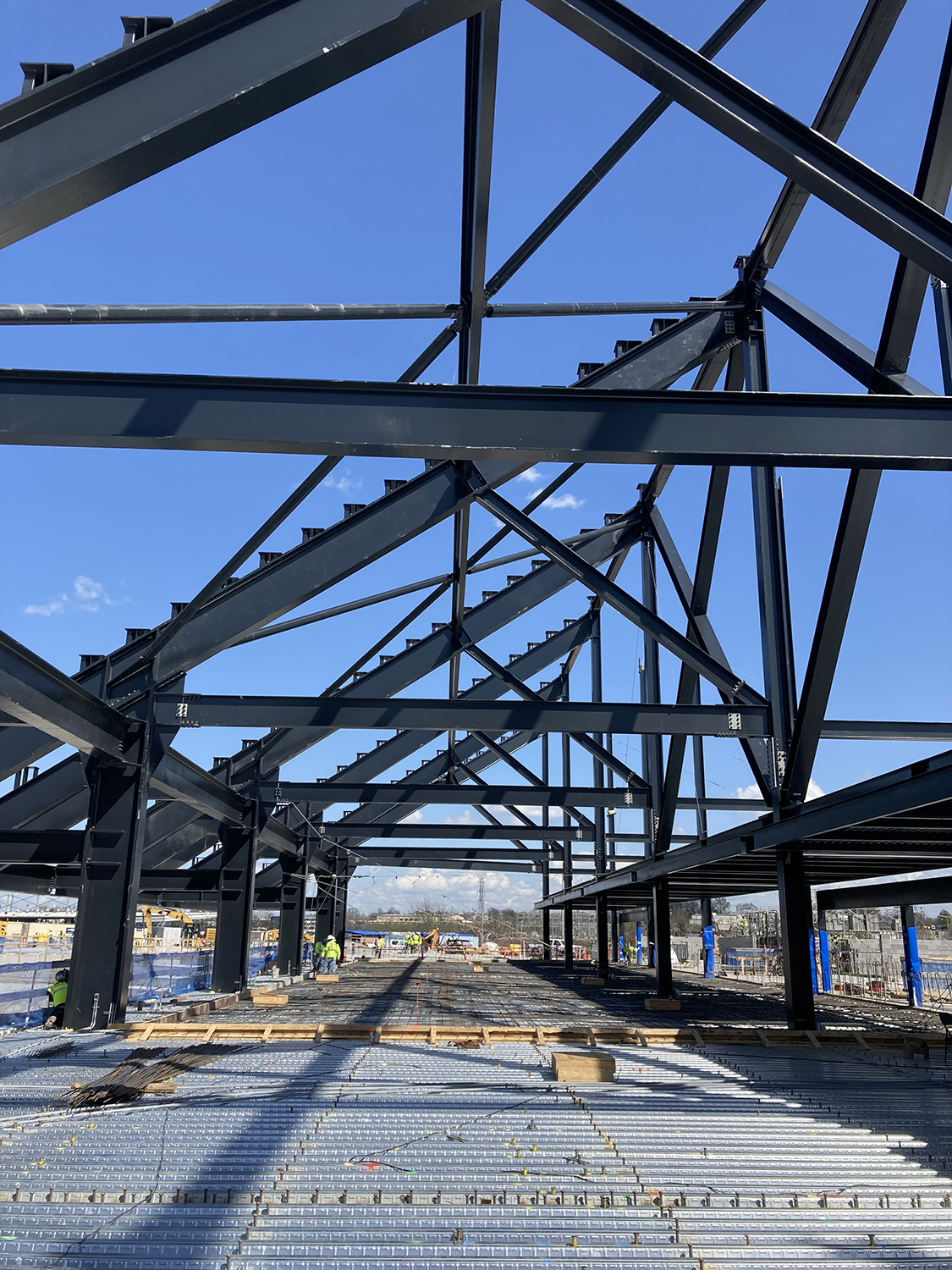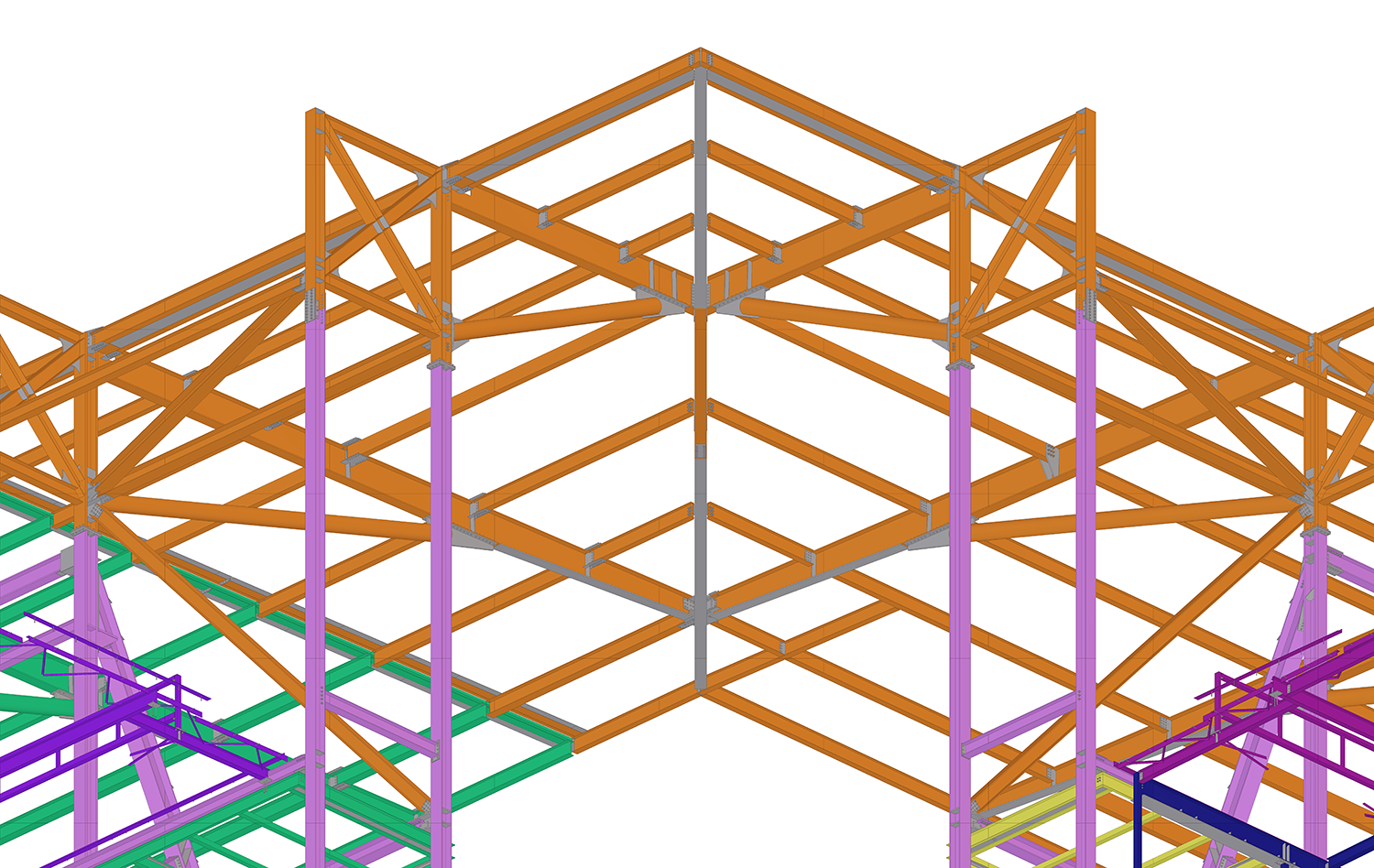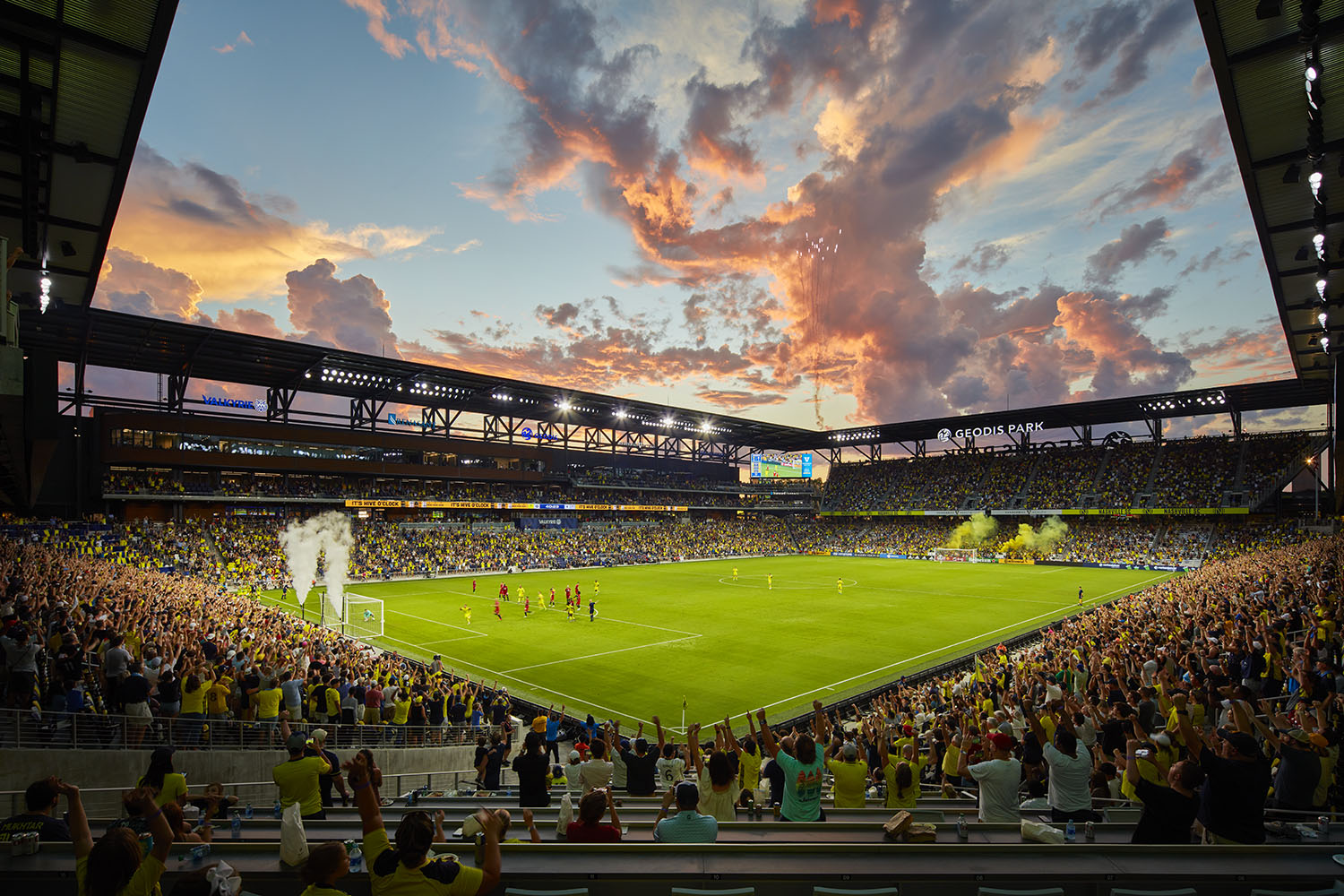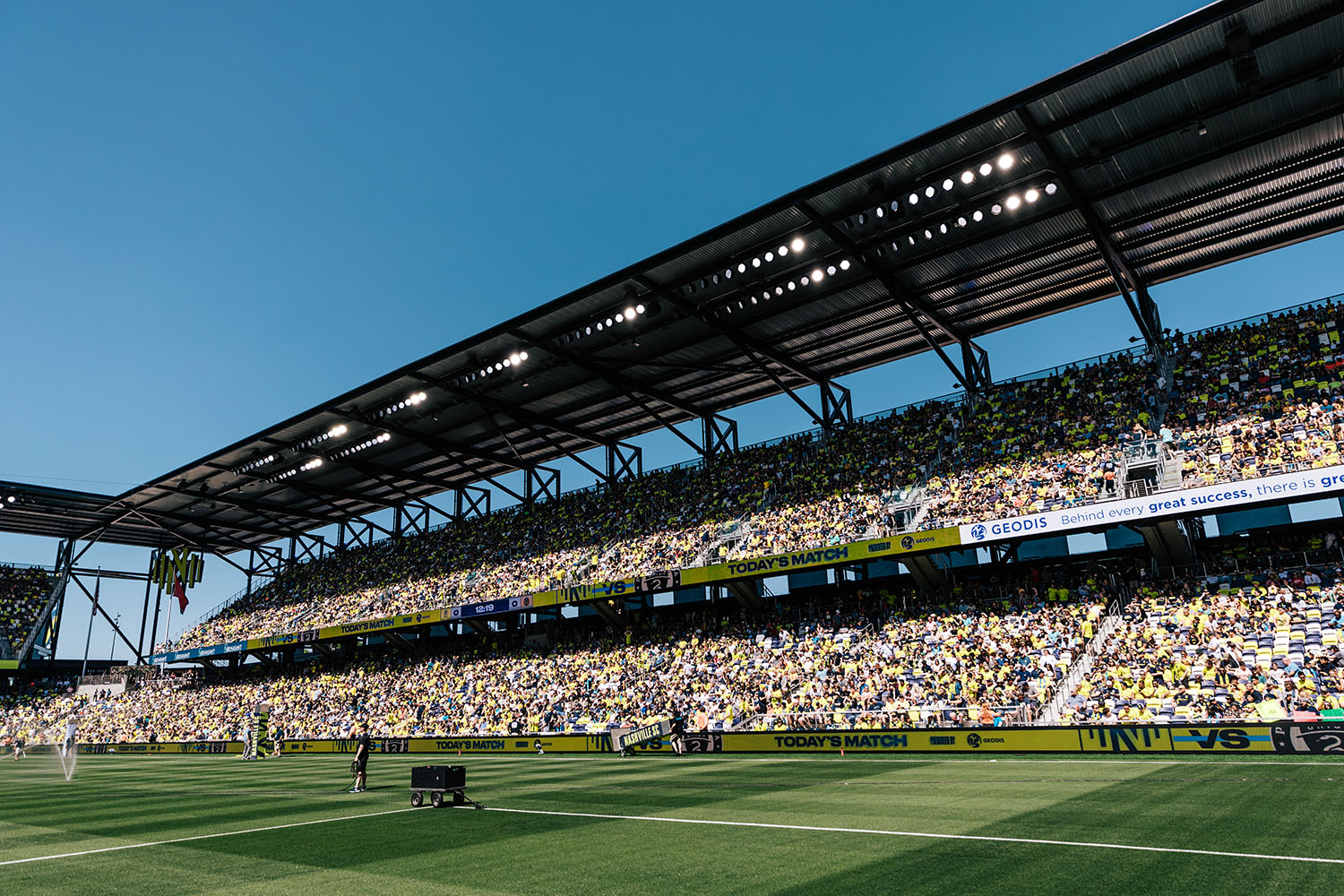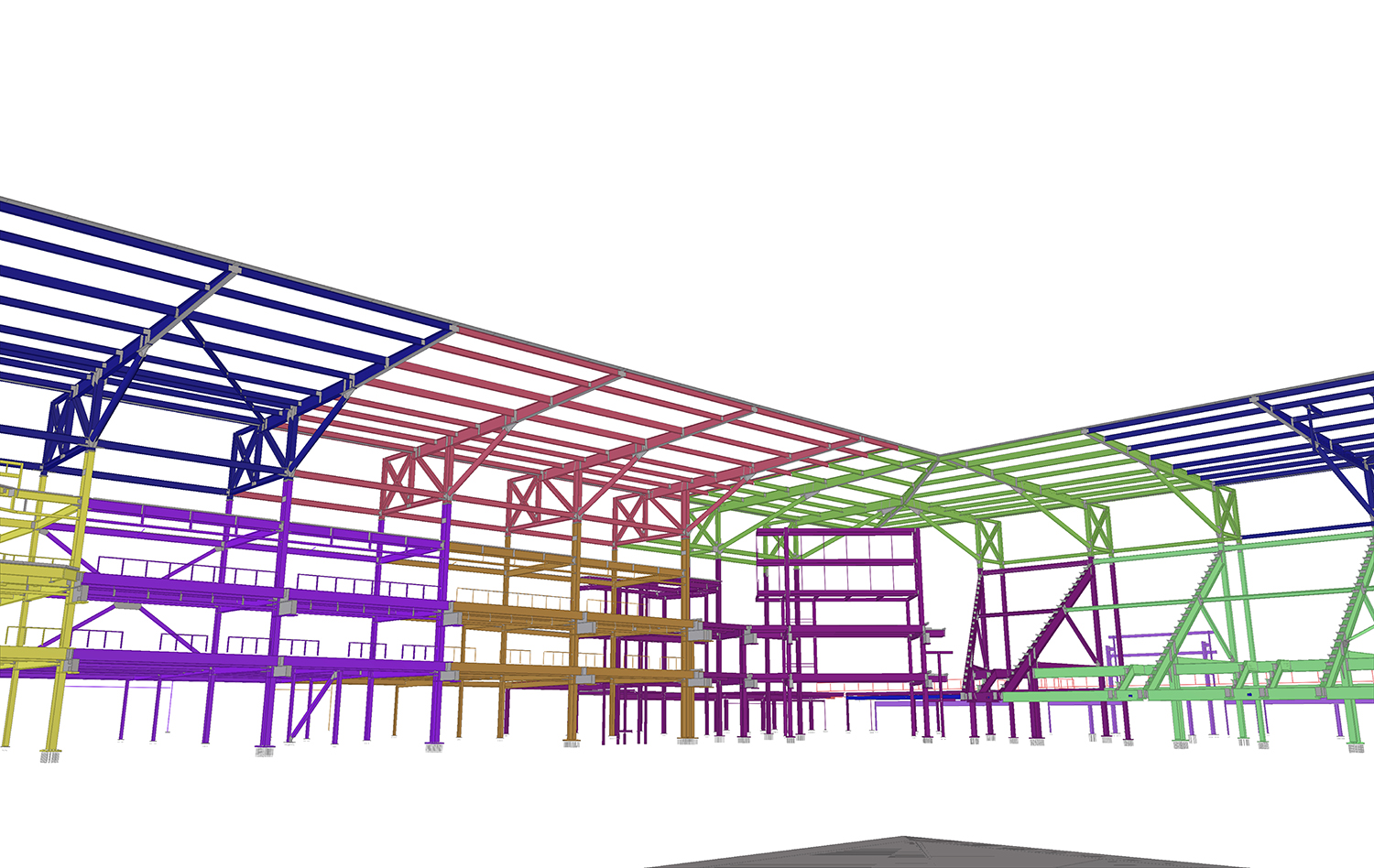AISC
GEODIS Park
Excellence in Constructability
"The repeatable, simple design is well-executed and well-presented. It demonstrates the use of structural steel as both a structural element and an architectural element. It really shows the value you can get with structural steel." -- Brian C. Smith, Vice President, Doing Steel Fabrication, 2024 IDEAS² Awards Judge
Nashville's GEODIS Park made history the moment it opened.
The 30,000-seat venue, home to Major League Soccer’s (MLS) Nashville SC, is the largest purpose-built soccer stadium in the United States and Canada. It’s designed to capture Nashville’s distinct architectural character and is constructed from structural steel, mass timber, and exposed brick.
GEODIS Park was built to do more than host soccer matches. It’s the anchor of a renewal effort in the city’s historic but underutilized Nashville Fairgrounds, a well-loved destination known for its 50-year-old flea market, short-track speedway, and municipal fairs. It catalyzed more than $500 million in investments in the historic but underserved neighborhood.
The stadium’s carefully crafted exposed steel, mass timber, and exposed brick expresses the city’s industrial roots and echoes the industrial architecture prevalent throughout Nashville while improving sustainability and reducing overall construction costs. Limited cladding on the stadium’s exterior makes exposed structural steel the dominant architectural material, and the steel gracefully integrates with the dowel laminated-timber (DLT), precast, and masonry systems.
Structural steel was the natural choice as the primary element of the stadium. It provides the needed strength to support the long spans in the seating bowl, canopy cantilevers, and extra-wide concourses while conveying the chiseled aesthetic sought by the client to reflect Nashville’s industrial roots.
The exposed steel elements, in concert with brick and timber, create the public spaces and the dynamic visual form of the structure, and carefully crafted connections give it the desired industrial feel. The innovative and client-responsive structural engineering set a new standard for the design and construction of a complex structural steel building, meeting all client needs and creating a new asset for the city of Nashville while showcasing structural steel.
Numerous exposed structural steel features greet fans as they enter GEODIS Park, including:
- A 360° steel canopy cantilever that extends 85 ft over the upper seating bowl
- A signature steel X-frame, incorporating W14s for the columns and cross-bracing members, at the stadium canopy around the seating bowl
- A 65-ft-wide concourse with fully exposed steel connections
The stadium’s signature 152,600-sq. ft, 360° main canopy enhances the architectural expression of the stadium with crisp 90° corners at each entry and a rectangular opening over the pitch. It also created significant design complexity that demanded innovative engineering.
Structural steel’s strength permits the graceful and economical 85-ft canopy cantilever that protects 80% of seats from sun and rain. The main canopy girder has a single propped strut supported by the signature X-frame that serves as an elegant hold-down at each grid. These open corner entries are the stadium’s signature architectural features. The main canopy continues 48 ft beyond the last column line, creating a column-free space with a soaring canopy above. The four open corners create a distinctive aesthetic, allowing fans inside the stadium to see the city beyond and fans approaching the stadium to see inside.
Steel provided the flexibility to integrate seamlessly with the other materials chosen for the project, including the precast concrete seating elements, mass timber at the entries, brick throughout the concourse, and other premium spaces. Steel became the foundational workhorse that formed the overall spaces and easily handled the long cantilevers, the complex geometry, and the need to be erected quickly. It nimbly supported exposed timber construction at each entry point and exposed brick masonry throughout the venue.
“The structural steel is the architectural hero of GEODIS Park and honors the industrial heritage of Wedgewood Houston, the neighborhood where the stadium is located,” said Chris Melander, a design architect with Hastings and the lead project designer. “The steel detailing is integral to the stadium’s identity and is celebrated with muscular bolted connections and contoured stiffeners.
“Collaborating with Walter P Moore in an integrated delivery process allowed the design team to influence and tailor the connection design, ensuring their compatibility with the overall design intent. Collaboration helped our team coordinate pathways for stadium utilities without sacrificing the structure’s beauty and created schedule efficiencies by allowing the steel fabrication to begin much sooner than with a traditional delivery method.”
Masterful Modelling
Walter P Moore modeled all connections in 3D early in the project using a self-developed proprietary delivery process called ConnecTID, “Transformative Integrated Design for Buildings,” which fueled thorough discussions with the architect regarding the desired architectural expression. The advanced modeling fostered highly detailed coordination across all trades to ensure the aesthetic was achieved. That level of careful and advanced coordination helped integrate conduit, plumbing pipes, and other utilities into the building while maintaining each piece of the structure as an architectural feature.
The project’s first challenge was to design and coordinate an efficient exposed structural system that could economically support a modern MLS stadium’s many different span and load conditions. Early in the design phase, it became clear that exposed structural steel was the key architectural element. The challenge then became to develop, design, and detail every exposed steel member and connection early in the project so the engineer could fully coordinate every aspect with the architect and other project team members for aesthetic intent and functionality with various trades.
The solution was for the structural engineering team to fully model the structural steel superstructure to LOD400 completeness before procuring steel. LOD400 models are fabrication-ready models typically developed by a steel fabricator and include every part needed for steel fabrication, including bolts, welds, shim plates, stiffeners, and copes.
The fabricator performs LOD400 modeling on most projects after completing architectural coordination. On GEODIS Park, though, early high-fidelity modeling allowed the architect and engineer to visualize and refine every connection during design.
The engineer had to create a space-efficient concourse to accommodate the required concessions, restrooms, and other amenities while allowing free-flowing circulation for 30,000 fans. Conventional braced frames would have disrupted patron flow and consumed much of the limited concourse space.
Instead, the engineer leveraged the steel’s strength and adaptability by utilizing moment frames in both directions, maximizing patron circulation while providing the needed strength and lateral stability to support the concourse and canopy. The design team leveraged early high-fidelity detailing to enhance the structural steel expression throughout the concourse, including carefully sculpted raker-to-column connections at each grid.
The design and construction team worked under schedule pressure from the start, seeking to deliver the stadium on an accelerated time frame to enable the owner to host as many games as possible in the stadium’s opening season. Land acquisition issues threatened to delay stadium opening until midway through the 2022 soccer season, strengthening the schedule pressure.
ConnecTID facilitated ten weeks of process acceleration from a conventional stadium schedule by overlapping the LOD400 model development with the final design and construction bidding phases. The ConnecTID process and resulting LOD400 model also eliminated delays during construction to resolve coordination problems, because the design team identified and solved those potential problems virtually during the creation of the LOD400 model instead of solving them after discovery in the field.
The ConnecTID process tightly integrated structural steel design, connection design, and advanced 3D modeling to develop high-fidelity, fabrication-ready digital deliverables. It provided tight and accurate steel bids, improved overall coordination, and eliminated nearly all steel change orders costs. Six steel bids ranged from 9% to 20% below budget, with a total spread of 15% between high and low bids.
As a result, steel erection ended four weeks early, and the overall project wrapped up seven weeks earlier than planned. The schedule savings allowed Nashville SC to play the entire 2022 season at GEODIS Park, generating revenue nearly two months earlier than anticipated.
The early and thorough LOD400 detailing allowed design details down to the bolt’s orientation and tapered shapes of every stiffener plate to be considered part of the overall architectural intent. Thorough connection design by the structural engineer is uncommon for modern stadiums and makes GEODIS stand out to patrons for its well-crafted appearance throughout.
Having steel as the dominant architectural feature of GEODIS Park meant the exposed steel had to be intentionally designed and detailed to be exposed throughout the stadium. In typical projects, particularly in the eastern half of the United States, connection design is delegated to the steel fabricator and is completed after design team drawings are issued with limited interaction between the connection designer and the design team. In this case, the ConnecTID process began in early design development, as the structural engineer collaborated with the architect on preliminary connection concepts for the critically exposed connections on the project.
The engineer then modeled an entire frame of connections in Tekla for review by the architect. Starting the connection design early in the project allowed for multiple iterations on the exposed connection, with the design team reviewing in Tekla each time to capture the overall impact. The details were then documented on early pricing sets to capture the complexity of the connections for accurate pricing.
Additionally, starting the process early and designing the connections during the design phase allowed coordination with the entire design team. The early coordination helped the team create pathways for the conduit to run inside steel column webs by stopping stiffeners or creating openings in gusset plates. Drainpipes were routed through beam openings, effectively hiding the piping at the leading edge of the bowl rather than having the pipe visually exposed going under beams.
Crafty Constructability
GEODIS Park’s steel delivery process combined numerous industry-leading activities to create a modern and streamlined construction process. It stands out as a model for the future of structural steel delivery compared to other stadiums with construction delays and cost overruns.
The ConnecTID process is based on producing more detailed and complete design information that includes fabrication-ready bid documents, meaning the steel fabricator bidders have a clearly defined project scope. In typical projects, the fabricator performs steel connection design and LOD400 modeling. But the GEODIS Park team pulled those services forward to have the engineer of record complete them during the design and bidding phases. These services are typically 3% to 5% of the total steel contract and require the owner’s early investment to complete.
The engineer of record providing connection design and LOD400 modeling transformed and accelerated the entire delivery and documentation process. The steel bid documents included a traditional set of construction documents, structural steel specifications, completed connection design (including 3D representation on the drawings for all the complex connections, connection design for the vast majority of typical beam-to-beam and beam-to-column connections, and the LOD300 Tekla model (called the stick model).
The engineer rapidly transferred the steel members and geometry from the Revit model to a LOD300 Tekla model through a digital-based design process. The LOD300 model helped level-set the steel bidders for a baseline tonnage and piece count. The first half of the LOD400 Tekla model was released as an addendum, allowing fabricators to understand the exact project requirements.
The updated Tekla model also included locations and extents of all four steel finishes: exterior high-performance, galvanized, interior prime only, and interior fireproofed—which eliminated another common source of scope confusion.
The modified process resulted in multiple competitive and qualified bids, ultimately leading to a steel contract 10% below budget value.
The ConnecTID process completed the LOD400 model early, meaning trade coordination occurred at a higher fidelity immediately. Trade partners coordinated within pre-planned and fully modeled structural pathways. The model helped reduce steel RFIs by 90% from conventionally delivered projects. Most importantly, steel change orders totaled less than 3% of the contract value, about 70% less than what is commonly experienced in other highly accelerated steel projects.
Sustainability Success
GEODIS Park is the first professional stadium in the United States that couples the aesthetic and sustainability benefits of mass timber and structural steel by innovatively marrying them into a hybrid structural system that leverages the strengths of each material. The combination of minimalist steel frames and the long-span DLT decking created a resource-efficient dynamic entry feature that reduced the embodied carbon emissions of the stadium.
The strength and stiffness of steel provided the needed gravity and lateral support with just minimalist steel frames at 27 ft on center, providing ample width to optimize the positioning of entry queues and screening equipment, weather-protecting the equipment, and enhancing the guest experience. A pure timber structure would have been unable to accomplish these programmatic requirements.
Coupling steel and timber allowed each material to play to its strengths in a holistically optimized system. Additionally, the DLT panels do not have the environmental impacts associated with the glues required for CLT panels. The design team crafted hidden connections and utility runs. Fastener holes to connect the timber to the steel beams were pre-drilled in the shop, allowing quick and simple field installation of the timber. Perimeter steel channels conceal the roof slope, providing a clean steel perimeter fascia as the dominant architectural expression as fans approach the stadium.
For more on the GEODIS Park project, see “Southern Exposure” in the June 2023 issue of Modern Steel Construction.
Owner: Nashville Sports Authority, Nashville
Owner’s representative: CAA ICON, Denver
General contractor: Mortenson | Messer Construction Co., Nashville
Architects: Populous, Kansas City, Mo.; HASTINGS Architecture, Nashville
Structural engineer: Walter P. Moore and Associates, Inc., Kansas City, Mo.
Steel team:
- Fabricator: LeJeune Steel, Minneapolis *AISC full member; AISC-Certified fabricator*
- Erector: LPR Construction, Loveland, Colo. *AISC associate member; AISC-Certified erector*
- Detailer: DBM Vircon, Tempe, Ariz. *AISC associate member*
- Location: Nashville, TN
- Submitting Firm: Walter P. Moore and Associates, Inc.
- Photo Credit: 1, 4, 6 - © Tom Harris; 2, 3, 7 - © Walter P Moore; 5 - © Nashville Soccer Club


